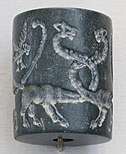Amorite language
Amorite is an extinct early Semitic language, formerly spoken during the Bronze Age by the Amorite tribes prominent in ancient Near Eastern history. It is known from Ugaritic, classed by some as its westernmost dialect and the only known Amorite dialect preserved in writing,[2][3][4] and non-Akkadian proper names recorded by Akkadian scribes during periods of Amorite rule in Babylonia (the end of the 3rd and the beginning of the 2nd millennium BC), notably from Mari and to a lesser extent Alalakh, Tell Harmal and Khafajah. Occasionally, such names are also found in early Egyptian texts; and one placename, "Sənīr" سنير (שְׂנִיר) for Mount Hermon, is known from the Bible (Book of Deuteronomy, Deuteronomy 3:9).[5]
| Amorite | |
|---|---|
| Native to | Levant |
| Extinct | 2nd millennium BC |
| Dialects | |
| Language codes | |
| ISO 639-3 | None (mis) |
| Glottolog | amor1239[1] |
Amorite is considered an archaic Northwest Semitic language, but there is also some evidence for other groupings.
Notable characteristics include the following:
- The usual Northwest Semitic imperfective-perfective distinction is found: Yantin-Dagan, 'Dagon gives' (ntn); Raṣa-Dagan, 'Dagon was pleased' (rṣy). It included a 3rd-person suffix -a (unlike Akkadian or Hebrew) and an imperfect vowel, a-, as in Arabic rather than the Hebrew and Aramaic -i-.
- There was a verb form with a geminate second consonant — Yabanni-Il, 'God creates' (root bny).
- In several cases that Akkadian has š, Amorite, like Hebrew and Arabic, has h, thus hu 'his', -haa 'her', causative h- or ʼ- (I. Gelb 1958).
- The 1st-person perfect is in -ti (singular), -nu (plural), as in the Canaanite languages.
Notes
- Hammarström, Harald; Forkel, Robert; Haspelmath, Martin, eds. (2017). "Amorite". Glottolog 3.0. Jena, Germany: Max Planck Institute for the Science of Human History.
- Woodard, Roger D. (2008-04-10). The Ancient Languages of Syria-Palestine and Arabia. Cambridge University Press. p. 5. ISBN 9781139469340.
- Goetze, Albrecht (1941). "Is Ugaritic a Canaanite Dialect?". Language. 17 (2): 127–138. doi:10.2307/409619. ISSN 0097-8507. JSTOR 409619.
- Kaye, Alan S. (2007). Morphologies of Asia and Africa. Eisenbrauns. p. 49. ISBN 9781575061092.
- Woodard, Roger D. (2008-04-10). The Ancient Languages of Syria-Palestine and Arabia. Cambridge University Press. p. 5. ISBN 9781139469340.
References
- A. Andrason and J.-P. Vita, "Amorite: A Northwest Semitic Language?", Journal of Semitic Studies 63/1 ( 2018): 18-58.
- D. Cohen. Les langues chamito-semitiques. Paris: CNRS, 1985.
- I. Gelb. La lingua degli amoriti, Academia Nazionale dei Lincei. Rendiconti 8, no. 13 (1958): 143–163.
- H. B. Huffmon. Amorite Personal Names in the Mari Texts: A Structural and Lexical Study. Baltimore, 1965.
- Remo Mugnaioni. “Notes pour servir d’approche à l’amorrite” Travaux 16 – La sémitologie aujourd’hui. Aix-en-Provence: Cercle de Linguistique d’Aix-en-Provence, Centre des sciences du language, 2000, p. 57–65.
- M. P. Streck. Das amurritische Onomastikon der altbabylonischen Zeit, vol. 1: Die Amurriter, Die onomastische Forschung, Orthographie und Phonologie, Nominalmorphologie. Alter Orient und Altes Testament Band 271/1. Münster, 2000.
